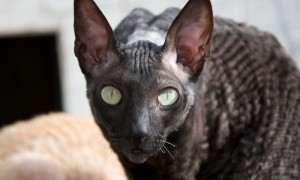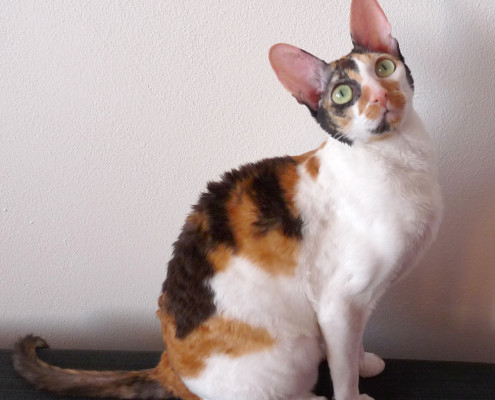Cornish Rex

Meoww!!
The Cornish Rex is a strikingly unusual cat, which looks like somewhat of a mix between the Egyptian statues of Bastet (the ancient solar and war goddess) and an alien from another planet. Despite its appearance, however, it has a friendly personality.
In 5 Words
- Active
- Affectionate
- Curly
- Curious
- Friendly
Snapshot
WEIGHT RANGE:
Male: small: <8 lbs.
Female: small: <8 lbs.
EYE COLOR:
Amber, Aqua, Blue, Copper, Green, Gold, Hazel, Odd-eyed, Orange, Yellow
EXPECTATIONS:
Longevity Range: 9-13 yrs.
Social/Attention Needs: Moderate
Tendency to Shed: Low
COAT:
Length: Short
Characteristics: Crimped
Colors: White, Blue, Black, Cream, Red, Brown, Frost, Platinum, Fawn, Chocolate, Chestnut, Cinnamon, Lavender, Champagne, Seal
Pattern: Solid color, Tortoiseshell, Bicolor, Tricolor/Calico, Tabby, Ticking, Smoke, Points, Shaded
Less Allergenic: No
Overall Grooming Needs: Low
CLUB RECOGNITION:
Cat Association Recognition:
CFA, ACFA , FIFe, TICA
Prevalence: So-so

Characteristics
Learn About the Cornish Rex
In July 1950 in Cornwall, England, an unusual kitten was born among an average British Domestic Shortair cat’s litter. This cream-colored male was covered with tight rows of tiny curls. As the kitten matured, his unusual look became more dramatic.
The owner of the cat consulted with a British geneticist and it was determined that the kitten was a result of a natural gene mutation. The geneticist suggested that the male kitten be bred back to his mother to perpetuate the look. The result was two curly kittens out of a litter of three.
The name Rex was taken from the similar coat type seen in Rex rabbits. The breed was accepted into the Cat Fanciers Association in 1962. The International Cat Association and the American Cat Fanciers Association also recognize the Cornish Rex.
The energetic and elegant Cornish Rex bounces through life and into your heart with undaunted enthusiasm. They are a natural breed originating from a mutation first recognized in England. Often referred to as the Greyhound of the cat world because of their long legged body complete with tuck-up, the Cornish Rex is easily recognizable by its wavy marceled coat. These curls go from their eyebrows to their whiskers and all over their body. There is NO hypo-allergenic cat, but the Cornish is considered a good choice for people with allergies as they do not seem to aggravate them as much as other cats. Their large tall ears and soft, big oval eyes blend into their egg-shaped head giving them a wonderfully expressive appearance. Smart, social cats, they know their place…right in the middle of everything!
The Cornish Rex is a highly intelligent, affectionate and extroverted breed, notwithstanding its somewhat aloof and sophisticated appearance. It is curious, inventive, playful and mischievous by nature, making it an endearing household companion and a wonderful pet. Most Cornish Rex like to play fetch and chase with other pets and with people. They are unusually acrobatic and enjoy leaping onto and off of high places, seemingly simply for the sheer joy of it. The Cornish Rex is an adventurous animal that readily adapts to new situations and environments. It will explore wherever – and whenever – it can. It often will be seen jumping into or onto refrigerators, examining washing machines or climbing into open clothes driers. Some owners consider these antics to be deliberately provocative on the part of their cats, but in a completely fun and happy way. The Cornish Rex is outgoing and people-oriented. It seeks out human companionship and the fellowship of other household animals. Most representatives of this breed make very suitable pets for children or adults who are timid around other animals.
The Cornish Rex is considered elderly at 8-10 years old, and yearly blood tests from this age on are a good idea to aid early diagnosis of problems such as kidney disease. Selecting a qualified breeder or buying from a reputable pet store can help ensure that your Cornish Rex will live a strong and healthy life. Maintaining your Cornish Rex’s proper weight and grooming requirements will also help maintain its good health, along with regular checkups at the vet.
You might expect the ultra-shorthaired Cornish to need no grooming. Unfortunately, that’s not always the case. Some rex require regular bathing because of the buildup of sebaceous secretions. All cats produce these normal oily secretions, but Cornish rex don’t have as much hair to absorb them as ordinary cats. Allowed to collect, these oily secretions can make the coat look greasy and can even cause skin problems. The need for bathing depends a lot upon the individual cat, however. Some need weekly bathing, while others need a bath every few months. Either way, it’s important to train your Cornish to tolerate bathing early, starting at 16 weeks or so. Since the Cornish’s short, thin coat dries quickly, bathing is not the ordeal it is for ordinary cats.






